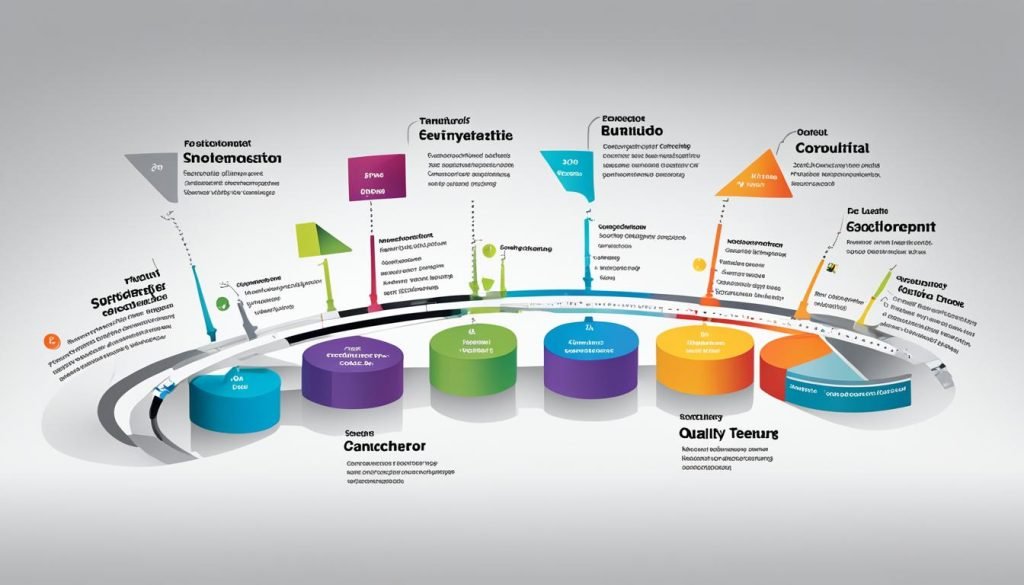
Product Lifecycle Management (PLM) guides products from idea to market exit. It uses specific methods for product development, launch, and improvement. This is all to meet what customers want and fit business aims. In this article, we’ll share insights on mastering PLM. This includes its main stages, advantages, and tactics.
Key Takeaways:
- PLM is a strategic approach that manages products throughout their lifecycle.
- Structured methods in PLM help align product development with customer needs and business goals.
- Mastering PLM involves understanding its stages, benefits, and key strategies.
- Successful implementation requires cross-functional collaboration and the use of PLM software.
- Aligning PLM strategies with the overall business strategy is crucial for optimized product offerings.
Understanding Product Lifecycle Management (PLM)
Product Lifecycle Management (PLM) is about tying all parts of a product’s journey together. It joins people, the way things work, the tech used, and info about the product. PLM is crucial for managing products well, making teamwork smooth and coordinating with others around the world.
PLM simplifies how products are made. It gives a single place for teams to handle product details, check progress, and talk to each other. All the steps from coming up with ideas, designing, handling the supply, to launching and selling, are included in PLM.
Using PLM helps companies be more creative, cut costs, and keep high quality from start to finish. It makes teams like those in engineering, marketing, and helping customers, work well together.
“PLM enables companies to manage the complexity of product development, from concept to market. It provides the framework for integrating processes and aligning business strategies.”
PLM is also key for keeping the supply chain running smoothly. It links everyone from the suppliers to the sellers. This helps with managing what’s in stock, sending out orders, and moving stuff around efficiently.
PLM also does a lot for how products are sold and supported. It helps companies learn what their markets want through research. This way, companies can improve their products based on what customers really need.
PLM also boosts how well companies can serve their customers. It lets them keep all the important details about their products in one place. So, they can quickly and clearly tell customers about their products. This makes dealing with any questions or problems much easier.
Overall, PLM is a big help for making better products, managing the supply chain well, and selling smarter. With good PLM in place, companies are more ready to stand out in a competitive market.
Key Stages of Product Lifecycle
The product lifecycle has four stages: introduction, growth, maturity, and decline. Each one is key in a product’s life, bringing unique challenges and changes.
Introduction:
The start is the introduction stage. It’s when a product launches. Here, companies aim to create buzz and find early fans. Getting this part right is crucial for a product’s future success.
Growth:
The growth stage sees big jumps in sales and market reach. Companies work hard to get more customers and open new ways to sell. This period is all about making money and getting a solid spot in the market.
Maturity:
In maturity, sales slow down, and the market is full. Competitors rise, pushing companies to stand out. They focus on keeping customers happy, encouraging more buys, and updating the product to keep it fresh.
Decline:
Things slow down in the decline stage. Sales drop because of market changes or the product getting old. Here, companies tackle tough choices. They might stop selling the product or try to make it popular again.
Knowing the product lifecycle helps companies a lot. It guides them on how to manage their products well and make smart moves. It shows them where their product is and what to do next for success.

| Stage | Description |
|---|---|
| Introduction | Product is launched into the market, focusing on generating awareness and attracting early adopters. |
| Growth | Rapid sales growth and market penetration. |
| Maturity | Stable period of sales and market saturation. |
| Decline | Sales start to decline due to market changes or product obsolescence. |
Implementing Product Lifecycle Management
Implementing an effective Product Lifecycle Management (PLM) strategy is key for businesses. It helps them make the best products and succeed in the long run. This part will look at how to set up PLM. This includes using a team from different parts of the business, special PLM software, matching PLM with the business strategy, and keeping data well managed.
The Power of a Cross-Functional Team
A successful PLM setup needs a team with people from many areas like design, engineering, and others. This mix makes sure unique views and skills help throughout the product’s life. It helps in making good decisions and solving problems well.
Having team members from each area improves talking. It can solve problems before they get big and push for more new ideas. This teamwork is key in making PLM work well by connecting everyone involved.
Optimizing Data Management with PLM Software
To handle all the data about products, companies can use special PLM software. This software makes sharing and finding data very easy. It stops data from being kept in different places or copied too much.
This PLM software makes data more right, easy to find, and faster to use. It also means teams can work together easily, wherever they are.

Aligning PLM Strategies with Business Goals
It’s key to link PLM strategies with what the business wants to do. PLM should help reach the company’s goals and customers’ needs. It should catch market trends well.
Linking PLM with business goals helps in many ways. It makes product-making better, helps find new ideas, and uses resources well. This helps in staying top-notch in the market, handling changes fast, and pleasing customers with what you offer them.
Effective Data Management for Successful PLM
Data management plays a big role in PLM because it ensures the right people have the correct info. Doing it right means making clear cuts about who is in charge of data, setting rules on what data is more important, and checking the data is correct and safe.
Good data management needs clear plans, the right rules, and the best technology. It’s about making sure data is good at every step from start to end.
Making PLM work well is all about planning and getting data right, following the best ways in the field and government rules as needed.
The Ideation and Design Stages
When a new product is coming to market, the first steps are very important. Ideas and their designs are key. They help turn thoughts into real plans. This is essential for any new product to be a success.
Ideation: Generating Innovative Ideas
The start of creating a new product is all about thinking up new ideas. This phase involves a lot of research to find out what customers really need. It’s about noticing what’s missing in the market and what people truly want.
Market research allows companies to deeply understand who they’re aiming to help. It shows their problems and dreams. With this knowledge, businesses can create products that really make a difference.
Here, different teams come together to think of new and creative ideas. The team might have people from many fields like product management, design, engineering, and marketing. Each brings their unique view to the table.
The Design Process: Transforming Ideas into Reality
After gathering lots of good ideas, the next step is designing how the product will look and work. This part turns dreams into clear plans. It shows exactly what the product will be.
Designers and engineers work side by side. They make detailed plans, drawings, and maybe even models. They think about how to make the product and its cost. This makes sure the plan is realistic and smart.
Building a model or prototype is really important. It lets designers check if their ideas are good. The model might show something needs to change or be better. Fixing this early on makes the final product even better for customers.
The ideas and design work are the heart of making a product. They lay the path for a great launch. With the right research, teamwork, and careful planning, new products can be both amazing and successful.
The Production and Distribution Stages
After planning and designing, we enter the production and distribution stages. These are key to getting the product out to people.
Production Stage
First, we set up the manufacturing and get the materials we need. Then, it’s about making sure each step meets high standards. Skilled teams and machines turn materials into the final product.
A detailed plan is a must during production. It ensures we make the right amount, use resources wisely, and keep quality high. Meeting what customers want is our goal.
Quality checks are more important than ever now. We must test and inspect products to guarantee they’re the best. Following strict rules helps keep buyers happy.
Distribution Stage
With products ready, we focus on getting them to customers. This includes storing, shipping, and filling orders. Different paths like direct sales, partnerships, or e-commerce may be used.
Direct sales connect companies straight to their customers, either in person or online. Partnerships with retailers can also help get products into stores or on websites.
Selling online has become a big hit. It opens up new ways for customers to buy. Plus, companies reach more people this way.
Handling shipping and stock is a big deal now. Making sure products arrive at the right time and place is our job. We coordinate all the shipment details.
“The production and distribution stages are vital. Good manufacturing and smart sales strategies help products find their way to customers effectively.”
These steps are very important for a product’s success. By planning well, keeping quality in check, and having strong shipping strategies, we ensure customers get what they need.
| Production and Distribution Stages | Key Elements |
|---|---|
| Production Stage |
|
| Distribution Stage |
|
The Disposal Stage and Conclusion
When a product’s life ends, it’s vital to dispose of it properly. This step is key in protecting the environment. Companies should use disposal methods that focus on recycling and reusing. This is important for sustainability.
Taking part in eco-friendly disposal methods helps save resources and cut down on waste. Recycling materials saves new resources. Repurposing products into new uses makes them last longer, which is good for the planet.
Sustainable disposal also means following environmental laws and using eco-friendly methods. Companies must choose ways to manage waste that are good for the environment.
Sustainability should guide how we handle a product from start to finish. Disposing of items thoughtfully shows a company cares about the world. It builds a positive image for being a green and ethical business.
The Importance of Sustainable Disposal
“Sustainable disposal practices, such as recycling and repurposing, are critical for preserving the environment and conserving resources.”
Sustainable disposal has many good outcomes. It helps lessen greenhouse gases, uses less energy, and protects resources. Also, it lessens harm to our planet and health from bad waste practices.
Using sustainable disposal methods supports a circular economy. This means we use new resources less and use old ones way better. It’s about creating a future where we’re smart and caring, from start to finish.
Conclusion
To get good at managing product lifecycles, companies must work as a team across different departments. They need to use PLM software well and make sure all efforts match the business’s overall plan. These steps help companies make their products better, carry on making improvements, and do well in the market.
Improving products over time is a crucial part of managing their lifecycles. This involves finding what customers want through studies, feedback, and looking at data. When companies keep their products up to date, they stay ahead of the competition and meet their customers’ changing needs.
Getting better all the time is key to great product management. It involves always looking for ways to improve. This means getting input from customers, partners, and teams within the company. By constantly making their products and processes better, companies can succeed.
Using strategies to manage products from start to finish, companies can handle every stage well. This total approach lets companies use their resources well, cut down on waste, and increase the value they provide to customers. With careful planning, working together, and always aiming to do better, companies can make it through the product lifecycle successfully and reach their objectives.



38 replies on “Mastering Product Lifecycle Management: From Concept to Market”
Can you be more specific about the content of your article? After reading it, I still have some doubts. Hope you can help me.
Your point of view caught my eye and was very interesting. Thanks. I have a question for you.
Thank you for your sharing. I am worried that I lack creative ideas. It is your article that makes me full of hope. Thank you. But, I have a question, can you help me?
Everything is very open and very clear explanation of issues. was truly information. Your website is very useful. Thanks for sharing.
Your article helped me a lot, is there any more related content? Thanks!
Your point of view caught my eye and was very interesting. Thanks. I have a question for you.
Thank you for your sharing. I am worried that I lack creative ideas. It is your article that makes me full of hope. Thank you. But, I have a question, can you help me?
Thanks for sharing. I read many of your blog posts, cool, your blog is very good.
This is a topic that is near to my heart…
Best wishes! Where are your contact details though?
Also visit my page nordvpn coupons inspiresensation, easyurl.cc,
Please let me know if you’re looking for a article author for your blog.
You have some really good posts and I feel I would be a good asset.
If you ever want to take some of the load off, I’d love to
write some content for your blog in exchange for
a link back to mine. Please blast me an e-mail if interested.
Many thanks!
Here is my page nordvpn coupons inspiresensation
nordvpn coupons inspiresensation 350fairfax
Hi, i think that i saw you visited my web site so i came to “return the favor”.I’m attempting to find
things to improve my site!I suppose its ok to use some of your ideas!!
Thank you for your sharing. I am worried that I lack creative ideas. It is your article that makes me full of hope. Thank you. But, I have a question, can you help me?
I don’t think the title of your article matches the content lol. Just kidding, mainly because I had some doubts after reading the article.
Can you be more specific about the content of your article? After reading it, I still have some doubts. Hope you can help me.
For most up-to-date news you have to go to see world wide
web and on internet I found this website as a finest site for newest updates.
Review my website … Eharmony special coupon code 2025
You made some decent points there. I did a search on the subject and found most guys will go along with with your website.
Thank you for your sharing. I am worried that I lack creative ideas. It is your article that makes me full of hope. Thank you. But, I have a question, can you help me?
Howdy! This post could not be written any better!
Reading this post reminds me of my old room mate!
He always kept chatting about this. I will forward this page to him.
Fairly certain he will have a good read. Thanks for sharing!
my web page – vpn
You really make it seem so easy with your presentation but I find this matter to be actually something that I
think I would never understand. It seems too complex and
extremely broad for me. I’m looking forward for your next post, I’ll try to get the hang
of it! https://tinyurl.com/23ww4xyv gamefly
free trial
Good article! We are linking to this great post
on our site. Keep up the great writing. Vpn meaning https://tinyurl.com/24dyn2m6
Post writing is also a fun, if you know afterward you can write if not it is complex to write.
Thanks to my father who stated to me about this blog, this web site
is genuinely amazing.
You are my aspiration, I own few web logs and occasionally run out from post :). “The soul that is within me no man can degrade.” by Frederick Douglas.
I don’t think the title of your article matches the content lol. Just kidding, mainly because I had some doubts after reading the article.
Nice read, I just passed this onto a colleague who was doing a little research on that. And he just bought me lunch as I found it for him smile Therefore let me rephrase that: Thanks for lunch!
Hey very cool site!! Man .. Beautiful .. Wonderful .. I will bookmark your website and take the feeds additionally?KI am glad to seek out numerous helpful information right here within the publish, we’d like develop extra techniques in this regard, thanks for sharing. . . . . .
Good post. I be taught something more difficult on different blogs everyday. It should at all times be stimulating to learn content from other writers and practice a bit one thing from their store. I’d favor to make use of some with the content material on my blog whether or not you don’t mind. Natually I’ll give you a link in your web blog. Thanks for sharing.
Good day! This is kind of off topic but I need some advice from an established blog. Is it difficult to set up your own blog? I’m not very techincal but I can figure things out pretty fast. I’m thinking about making my own but I’m not sure where to start. Do you have any tips or suggestions? Appreciate it
Thanks for sharing. I read many of your blog posts, cool, your blog is very good.
Hi there to all, the contents existing at this website are in fact awesome for people
experience, well, keep up the good work fellows. https://tinyurl.com/yu2htvml eharmony special coupon code 2025
Hey very cool blog!! Man .. Excellent .. Amazing .. I will bookmark your site and take the feeds also…I am happy to find numerous useful information here in the post, we need work out more strategies in this regard, thanks for sharing. . . . . .
Your point of view caught my eye and was very interesting. Thanks. I have a question for you.
Your article helped me a lot, is there any more related content? Thanks!
Please let me know if you’re looking for a article writer for your blog.
You have some really good posts and I think I would be a good asset.
If you ever want to take some of the load off, I’d love to write some articles for your blog
in exchange for a link back to mine. Please send
me an e-mail if interested. Thanks!
Feel free to surf to my webpage http://winkler-martin.de/messages/61849.html
Thanks for sharing. I read many of your blog posts, cool, your blog is very good.
This is a very good tips especially to those new to blogosphere, brief and accurate information… Thanks for sharing this one. A must read article.
Thank you for your sharing. I am worried that I lack creative ideas. It is your article that makes me full of hope. Thank you. But, I have a question, can you help me?
I am continually browsing online for posts that can assist me. Thx!